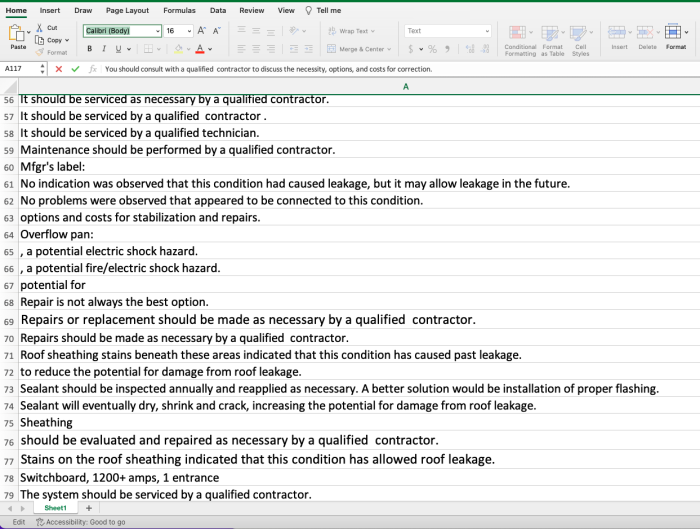Although we look at a wide variety of systems and components, we’re typically looking at how they age and fail and really, there aren’t that many different types of recommendations.
For example:
- “An evaluation should be performed by a qualified contractor to provide an estimate for work as necessary.”
- “, a potentially hazardous condition that should be corrected by a qualified electrical contractor.”
- “No indication was observed that this condition had caused leakage, but it may allow leakage in the future.”
- “Repairs or replacement should be made as necessary by a qualified contractor.”
- “You should consult with a qualified contractor to discuss the necessity, options, and costs for correction.”
A note about the use of "qualified contractor" in multiple comments.
In some states (Washington, Oregon, to some degree Illinois)if the buyer or their agent provides the entire report to the seller or their agent, the inspection contingency is deemed waived. This practice is to encourage seller disclosure.
Because the InterNACHI Narrative Library (INL) templates are sold to inspectors across N. America, comments contain the recommendation that any necessary repairs, corrections, evaluations, etc. be performed by a qualified contractor.
Over time, you’ll find that you use the same or very similar language for recommendations, and eventually, for descriptions. What you’re doing is developing a “lexicon”, which is a collection of terms used in a particular profession.
Developing a lexicon will reduce the time it takes you to write narratives because you won’t have to think as much about the word, terms, or phrase you’re looking for. Because you’ve used them hundreds of times, or like me you have them written down in an Excel spreadsheet, they’re right there at your fingertips.
I have a list of just over 160 in alphabetical order. If you’re working on a section of your template, in Excel you can use Find and Replace to insert different types of contractors into groups of narratives.

Developing a written list is helpful because you’ll begin to notice subtle differences that would be much less obvious if you were writing each narrative from scratch while trying to finish up a report. Under those circumstances we tend to use the first term that occurs to us because we’re trying to get that report finished. With a list, you can consider several options in the time it would otherwise take to come up with one acceptable term.
